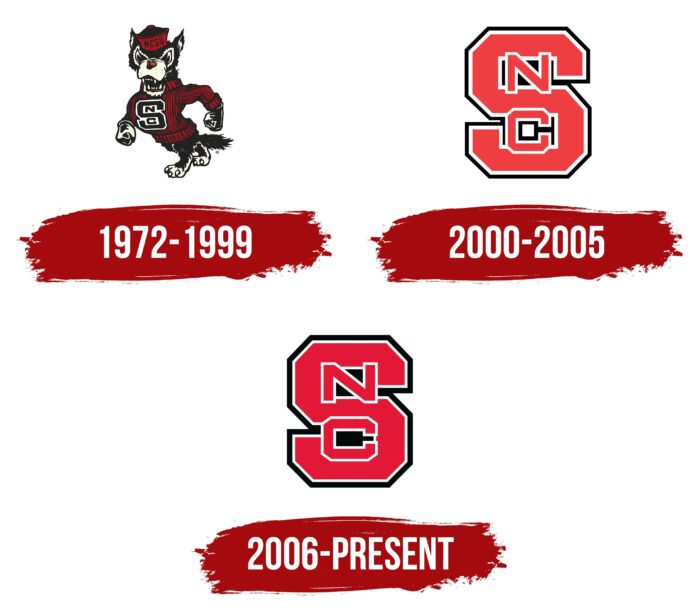The University of North Carolina is hard to miss. The institution is famous for its programs and participation in the state’s public life. The NC State University logo warns that a student enters an active, restless community by enrolling in this university.
NC State University: Brand overview
| Founded: | March 7, 1887 |
| Headquarters: | Raleigh, North Carolina, United States |
| Website: | ncsu.edu |
Meaning and History
The founder of NCSU is the North Carolina General Assembly, which issued a corresponding decree in March 1887. It was originally called the North Carolina College of Agriculture and Mechanic Arts or North Carolina A&M (short form). Only white students could apply to study there. The educational program mainly covered such areas as military affairs, mechanics, agriculture, and technical research work. The university immediately supported them developed them, expanding their powers along the way.
The first renaming of the university took place in 1917. Then it became known as the North Carolina State College of Agriculture and Engineering, or, more simply, North Carolina State. During the Great Depression, the leadership combined three educational structures into the University of North Carolina, NC State, and Woman’s College (now it is the University of North Carolina at Greensboro). In 1931, this association was renamed, receiving the status of the University of North Carolina. Then the educational programs expanded even more, and the university continuously grew, flourished, and developed.
The NCSU university-wide emblem is minimalistic, clear, and informative. And all because it consists of only two elements: a background in the form of a wide red rectangle and a white inscription on it. The university’s name is grotesque and occupies two lines: at the top is the phrase “NC State,” at the bottom – “University.” Designers used different fonts for them. The largest is the first. This was done intentionally since this part is shorter than the second, and to balance them visually, the authors simply enlarged the letters. At the bottom, the symbols are much thinner and neater.
Seal
The academic seal of the university is adorned with the main tower of North Carolina State University. It is located in the center and exactly repeats the design of a real building. A tall column stands near one of the buildings, surrounded by trees and cumulus clouds. Although the print is rondel in form (a circle with a center, a wide stripe, and a ring-shaped frame), but in style, it is close to engraving. This type of artistic image is inspired by the combination of black and white elements as if carved or cast on an iron plate.
The text is around the column, the top of which extends far beyond the middle part. It rings the landscape with an architectural design and consists of the full name of the higher education institution and the date of its opening. The inscriptions are in bright red. This is followed by a narrow black and white frame decorated with an ornament.
North Carolina State Wolfpack Logo
The teams compete in the NCAA Division I and the ACC, winning eight national championships and several other titles. Their main logo is a geometric block of a large “S,” which serves as a background for the “N” and “C.” This configuration first appeared in 1890 and has undergone considerable evolution during its existence. But in 2000, she returned again in her original form. Athletes got the nickname Wolfpack for their behavior during one of the competitions when a fan called students a “wolf pack.” This happened in 1922. And before that period, the club often changed its name and was Aggies, Techs, Red Terrors.
1972 – 1999
The emblem consisted of a mascot nicknamed the Strutting Wolf. He is depicted in a caricature style and walking to the left. The eyes of an anthropomorphic predator are black, menacing, the ears are erect, the fists are clenched, and the mouth with sharp fangs is open in a roar. On the head of the wolf is a peakless cap with the grotesque abbreviation “NCSU.” The body is wearing a red and black striped sweater with a print on the chest. Three characters are drawn on it: a large “S,” small “N,” and “C.” The last two are located in the intra-letter gap of the largest character. The letters have a geometrically regular shape and cut corners along the outer edge.
2000 – 2005
After the redesign, it became clear that the university teams had abandoned the wolf’s image on the logo. Instead, they approved the monogram, which was used to decorate the clothes of an anthropomorphic talisman. The “S” is still highlighted in the image: it is bold, with a black and white border, and is much larger than the “N” and “C.” The first of them takes place at the top, the second – at the bottom. The rhomboid shape of the signs with beveled corners has been retained.
2006 – today
The designers have corrected the small details of the emblem, but the main components have not been touched. They narrowed the in-letter gaps of the “S” so that the other two characters now fit perfectly into the free space. In addition, the developers have changed the color palette, using rich scarlet – the color of victory and energy.
NC State University: Interesting Facts
North Carolina State University (NC State) is a leading public research school known for its strength in science, technology, engineering, mathematics (STEM), design, textiles, and agriculture.
- Origins: It started in 1887 as the North Carolina College of Agriculture and Mechanic Arts and aimed to provide practical education in agriculture and engineering. Now, it offers a broad range of programs.
- Campus: Located in Raleigh, NC State’s campus is over 2,100 acres and features the historic main campus, Centennial Campus for research and innovation, and the College of Veterinary Medicine campus.
- Research: Known for high-level research in nanotechnology, biotechnology, and materials science, the university is classified among “R1: Doctoral Universities – Very high research activity.” Centennial Campus houses over 70 research centers.
- Athletics: The athletic teams, known as the Wolfpack, compete in NCAA Division I, excelling in men’s basketball, football, and swimming and diving.
- Alumni and Faculty: Notable names include John T. Chambers (former CEO of Cisco Systems), James B. Hunt Jr. (former Governor of North Carolina), and Nobel Prize-winning chemist Paul L. Modrich.
- Partnerships: Centennial Campus serves as a model for public-private research, housing over 75 partners, which encourages collaboration and innovation.
- Sustainability: To tackle global challenges, the university focuses on sustainability, energy efficiency, waste reduction, and sustainable transportation.
- James B. Hunt Jr. Library: Opened in 2013 on the Centennial Campus, it’s known for its advanced design and technology, especially for engineering and textiles.
- Agricultural Extension: NC State plays a vital role in North Carolina’s agricultural extension service, offering resources, training, and support to the state’s agricultural community.
- Motto: “Think and Do” reflects the university’s mission to combine academic study with real-world application, emphasizing education and research’s practical impact.
NC State stands out for its academic excellence, cutting-edge research, and dedication to making a real-world impact, making it an important institution in North Carolina and globally.
Font and Colors
Despite the fundamental differences between the academic seal, the university emblem, and the sports logo, they still have a common feature. This is a color. In all three, red, white, and black are predominant. But their shape and details never matched because each type of identity needs its style – from strict to cartoonish.
For example, varsity teams use another type of wolf – wearing a cap with the inscription “NC State.” The logo shows the head of a predator with a vicious muzzle, open mouth, red tongue, and slightly pointed eyes. The strokes on the emblem are angular and sharp, which emphasizes the danger of the athletes, their irreconcilable disposition, and readiness to attack the enemy.
The base typeface of North Carolina State University is called Univers. The higher education institution has obtained a license to use most of the fonts in this family. Additional typeface – Glypha. The color scheme consists of two main shades (red, white) and one accompanying one (black).
NC State University color codes
| Racing Red | Hex color: | #cc0000 |
|---|---|---|
| RGB: | 204 0 0 | |
| CMYK: | 0 100 100 20 | |
| Pantone: | PMS Bright Red C |










